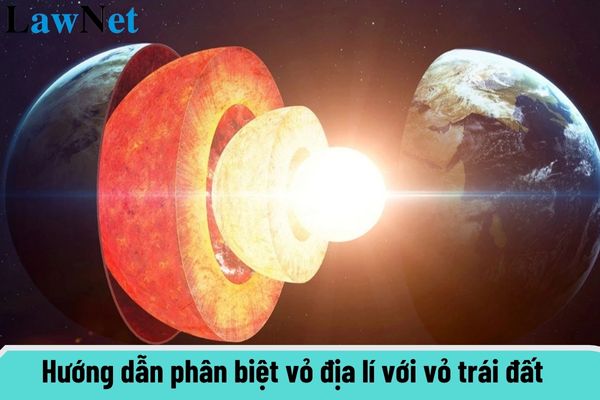What are the guidelines to distinguish the geographic shell from the Earth's crust? What are the orientations for teaching Geography in Vietnam?
What are the guidelines to distinguish the geographic shell from the Earth's crust?
Students may refer to the following guidelines to distinguish the geographic shell from the Earth's crust:
The Earth's crust is the physical shell, while the geographic shell is a complex system including many interacting natural components. Distinguishing these two concepts helps us understand more deeply about the Earth and the role of humans in environmental protection.
The geographic shell includes both the Earth's crust, and natural elements such as the atmosphere, lithosphere, biosphere, hydrosphere, and soil, which interact with each other.
The Earth's crust is the outermost structure of the Earth, which can be thick or thin depending on the region.
 Distinguishing the Geographic Shell from the Earth's Crust
Distinguishing the Geographic Shell from the Earth's Crust
This is a table distinguishing the Earth's crust and the geographic shell for students to refer to!
| Criterion | Earth's Crust | Geographic Shell |
| Thickness | Ranges from 5 km (in oceans) to 70 km (in continents) | Approximately 30 to 35 km thick from the lower limit of the ozone layer to the ocean's abyssal floor; on continents, down to the entire weathered crust |
| Material Composition | Composed of various rock layers such as sediment, granite, basalt, etc. | Includes the atmosphere, lithosphere, hydrosphere, pedosphere, and biosphere interpenetrating and interacting with each other. |
*Note: The information on the guide to distinguishing the geographic shell from the Earth's crust most accurately is for reference only./.

What are the guidelines to distinguish the geographic shell from the Earth's crust? What are the orientations for teaching Geography in Vietnam? (Image from the Internet)
What are the orientations for teaching Geography in Vietnam?
Under Section 6 of the General Education Program for Geography issued with Circular 32/2018/TT-BGDDT:
- Energizing students' activities; where the teacher organizes, guides, encourages, and creates a friendly learning environment for students; students learn proactively, actively, creatively, focusing on self-learning skills.
- Enhancing experiential activities for students, linking geography lessons with local, national, and global realities; applying knowledge to solve environmental, economic, and social issues locally, thereby developing awareness, skills, distinctive qualities, and general capabilities.
- Diversifying teaching methods, flexibly combining advanced teaching methods, specific teaching methods for the subject such as: using maps, diagrams, statistics, charts, pictures, models, observations, fieldwork, etc; improving and utilizing traditional teaching methods such as lectures, Q&A, etc
- Implementing diverse and flexible forms of teaching, combining individual learning, group learning, and class learning; in-class teaching, outdoor teaching, practical, fieldwork teaching; local tours, surveys, information collection, display, introduction, exhibitions, educational games, etc
- Organizing, guiding, and providing conditions for students to explore, discover, exploit, and capture knowledge from geographical teaching aids such as maps, atlases, pictures, models, observational, and measuring instruments, materials, documentation, etc
Encouraging and facilitating students to leverage information from the Internet to support learning; training students in skills to process, and present geographical information using information and communication technology, etc
- Increasing the self-production of teaching aids with the application of information and communication technology (creating learning websites, building a system of lessons, exercises, practices, and tests using common and suitable software, constructing video clips introducing geographical phenomena, etc).
What are the rights of students in Vietnam when studying Geography?
Under Article 35 of the lower secondary school, upper secondary school and multi-level school charter issued with Circular 32/2020/TT-BGDDT, the rights of students are stipulated as follows:
- Receive comprehensive education with fairness, be provided with time, facilities, hygiene and safety to learn in class and self-learn at home, be informed of their education and training, and be able to use learning, cultural and sport equipment of their schools as per the law.
- Receive respect, protection and fair and democratic treatment, complain to their schools and education authorities about decisions concerning themselves; transfer school with legitimate reason as per existing regulations; enter school before the compulsory starting age, skip a grade and study at an age higher than the compulsory attendance age according to regulations in Article 33 of Circular 32/2020/TT-BGDDT.
- Participate in activities for development of their gifts in academic subjects, sports and art organized by their schools if able to.
- Students eligible for social benefits, disadvantaged students and gifted students may receive sponsorship or other benefits as per the law.
- Transfer school if eligible according to regulations following school transfer procedures stipulated by the Minister of Education and Training.
- Enjoy other rights as per the law.

